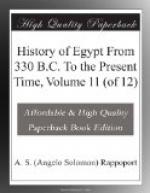For ten years the Egyptians were governed by the Persians, and had a patriarch of their own religion and of their own choice; and the building of the Persian palace in Alexandria proves how quietly they lived under their new masters. But Heraclius was not idle under his misfortunes. The Persians had been weakened by the great revolt of the Arabs, who had formed their chief strength on the side of Constantinople and Egypt; and Heraclius, leading his forces bravely against Chosroes, drove him back from Syria and became in his turn the invader, and he then recovered Egypt. The Jacobite patriarch Benjamin fled with the Persians; and Heraclius appointed George to the bishopric, which was declared to have been empty since John the Almsgiver fled to Cyprus.
The revolt of the Arabs, which overthrew the power of the Persians in their western provinces and for a time restored Egypt to Constantinople, was the foundation of the mighty empire of the caliphs; and the Hegira, or flight of Muhammed, from which the Arabic historians count their lunar years, took place in 622, the twelfth year of Heraclius. The vigour of the Arab arms rapidly broke the Persian yoke, and the Moslems then overran every province in the neighbourhood. This was soon felt by the Romans, who found the Arabs, even in the third year of their freedom, a more formidable enemy than the Persians whom they had overthrown; and, after a short struggle of only two years, Heraclius was forced to pay a tribute to the Moslems for their forbearance in not conquering Egypt. For eight years he was willing to purchase an inglorious peace by paying tribute to the caliph; but when his treasure failed him and the payment was discontinued, the Arabs marched against the nearest provinces of the empire, offering to the inhabitants their choice of either paying tribute or receiving the Muhammedan religion; and they then began on their western frontier that rapid career of conquest which they had already begun on the eastern frontier against their late masters, the Persians.




